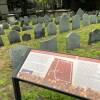In the next few months, a sign will go up on First Street in Cambridge displaying the thoroughfare's name in the language of the Massachusett Tribe. It's the first small step in a project to recognize the Native people who once lived in the region, a place they called Anmoughcawgen.
The project is the brainchild of Sage Brook Carbone, a Cambridge resident of Italian and Native ancestry. She is a member of the Northern Narragansett Indian Tribe of Rhode Island, as well as a descendant of Nipmuc, Massachusett and Mi'kmaq peoples. Carbone pitched the street sign idea after realizing how many names and places around Greater Boston acknowledged her Italian heritage, compared to those honoring her American Indian heritage.
“There are no streets named after Native people in Cambridge,” Carbone told GBH News. “To my knowledge, there are no squares commemorating Indigenous people. There are no distinctive markers of the historical nature.”
The state of Massachusetts was the first in the nation that colonizers recognized with an Indian name — meaning "great-hill-small-place"— and the city of Cambridge today sits on land belonging to the Massachusett Tribe. The plan to install street signs in their language is meant to recognize the Native people who lived on these lands before European traders and settlers arrived, and their descendants who live here today.
City officials say they know of no other city or town in the state that has posted signage in Native American languages.
”It's about visibility and normalizing, seeing Indigenous language in its written form on everyday infrastructure in our urban environment," said Sarah Burks, preservation planner at the Cambridge Historical Commission. "On street signs, it's going to be something that will make people stop and think.”

The first batch of signs will be for First through Eighth streets, city officials say. This excludes Fourth Street, which has already been renamed after World War II Pvt. Nicholas Sciarappa.
Carbone has been working with members of the Massachusett Tribe at Ponkapoag, scholars and the city to translate street names into the language of the Massachusett tribe. “The project is beginning with … translating numerical names of the streets because it's something that is universally recognized,” she said.
Later phases of the project may include adding historical markers to significant Indigenous sites and updating signs at city properties to include Native languages.
The project was approved through Cambridge's “participatory budgeting” system, which allows residents to submit proposals and vote on ideas for how to spend a portion of the city's budget. Carbone's proposal was merged with another one to replace historic markers on the existing African American Heritage Trail, a series of 20 locations around Cambridge where Black trailblazers lived and worked. The combined project was approvedwith a budget of $180,000.
Burks said many roads and towns in Massachusetts have Indigenous names, but they are not necessarily names that Indigenous people used for those locations.
"They've been changed," he said. "And it's not — it's not the same kind of idea,” because they are not intended to recognize Native American history.
David Shane Lowry, a Cambridge resident and an enrolled member of the Lumbee Tribe of North Carolina, says he hopes this effort will be the start of greater recognition of Indigenous peoples. "We always look for small steps because we know, as with a baby, small steps equal eventually to running and, you know, doing all kinds of other big stuff.”
Lowry said American history frequently tiptoes around the basic fact that the nation was built on land stolen from Native people, who were massacred, enslaved and largely erased.
The real goal, he said, is that “we as the colonial enterprise called Cambridge … continue to correct our presence by continuing to not only rename but to situate American Indian, Native American people in the center of what we do.”
Burks said the city is hoping to launch a website to accompany the new signs that will explain the project accompanied by audio clips of people reading the signs in the Massachusett language.
For Carbone, part of the goal of the signage project is to elevate Native American visibility. “We all have a right to see ourselves in the places that we live,” she said.
Beyond that, she said, the project is about understanding who has been included and who has been excluded from the telling of history.
“The bigger purpose,” she said, “is really just to have people think more about what the signs are around them. You know, what do these things say? Who decided what they say?”








